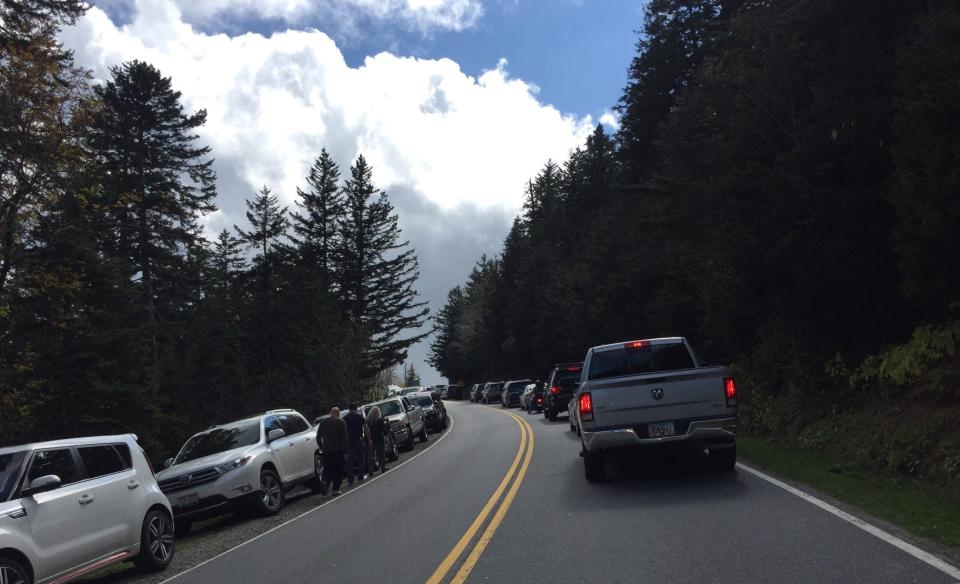Great Smoky Mountains to charge new parking fee, ban roadside parking near popular attractions
It's going to cost a little more to explore America's most visited national park next year.
After testing parking fees at its busy Laurel Falls last year, Great Smoky Mountains National Park announced Monday that starting March 1, 2023, parking tags will be required for all vehicles parking in the park for longer than 15 minutes.
The park, which does not charge entrance fees, also plans to ban roadside parking near some popular attractions and spend more money on law enforcement.
Here's what travelers should know about the Smokies' new "Park It Forward" plan and why the changes are coming.
Love national parks, but hate crowds?: See America's 10 least-visited gems
What to pack: Here are 20 essentials for national parks

How much will parking be at Great Smoky Mountains National Park?
Regardless of where or how people park, most every car visiting the Great Smokies will need a tag starting March 1.
The costs will be $5 for a daily parking tag, $15 for a seven-day parking tag and $40 for an annual parking tag, according to the park's website.
Tags will be available for purchase online and in person. They will be non-refundable, non-transferable and ineligible for upgrades.
They will not be required for motorists just passing through the area or parking for less than 15 minutes.
Grab that face mask: Great Smoky Mountains National Park requires masks again as COVID-19 cases rise
Where will roadside parking be banned?
"Roadside parking is being eliminated across the park in specific areas where the following concerns need to be addressed: motorist and pedestrian safety, resource protection and/or congestion," park spokesperson Dana Soehn told the Asheville Citizen-Times, part of the USA TODAY Network. "Specifically, in the first phase, we are eliminating unsafe roadside parking associated with busy trailheads along Newfound Gap Road, Little River Road, Clingmans Dome Road, Roaring Fork Motor Nature Trail and Cherokee Orchard Road."
Unsafe roadside parking will be eliminated in the Deep Creek and Big Creek areas as well, she added.
Story continues below.
How will Smokies visitors know where not to park?
The park has a plan to make it clear to visitors where they're not allowed to park.
Soehn said permanent roadside protections like wooden bollards, boulders, or split rail fencing and signs in these areas will be installed "so it is clear to motorists where roadside parking is prohibited," with the goal to "have everything in place by March 1."
Help wanted: Great Smoky Mountains National Park needs help tracking new, rare and invasive species
Will roadside parking be allowed anywhere?
The park will continue to allow some roadside parking.
"We understand this is a recognized need in some areas – especially along low-speed, gravel roads – where fishermen and others park to access streams in places where the roadside parking does not cause safety, congestion, or resource protection concerns," Soehn said.
Why is the park charging for parking?
A record high 14.1 million people visited the Great Smoky Mountains National Park in 2021.
Even though visitation jumped 57% over the past decade, the park says its operational budget hasn't grown proportionately and more funding is needed for park rehabilitation and preservation for future generations.
Park Superintendent Cassius Cash told the Citizen-Times Monday that his top spending priorities, based on conversations with the community, will be law enforcement and maintenance.
“We have 26 wastewater systems here,” Cash said, as an example of maintenance needs. “I can guarantee you if they’re not working, you’re going to know.”
He noted the park has stacked up $200 million in deferred maintenance. And said he wants funds to go to things like search and rescue efforts, traffic jams and bear jams.
The park also plans to use the funds for improving visitor experiences and protecting resources.
"100% of funds collected from these fees stay in the Smokies and go directly back into preserving the park and ensuring the visitor experience remains first-rate," the park said on its website.
Andrew Jones is a Buncombe County government and health care reporter for the Asheville Citizen-Times, part of the USA TODAY Network. Reach him at @arjonesreports on Twitter.
This article originally appeared on Asheville Citizen Times: Great Smoky Mountains National Park new parking fees start March 2023

